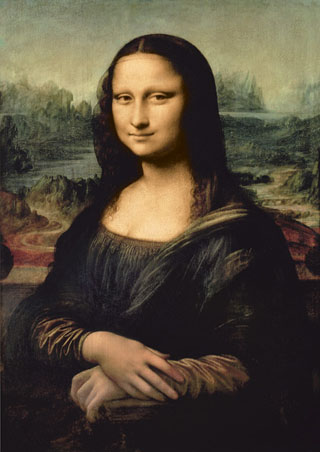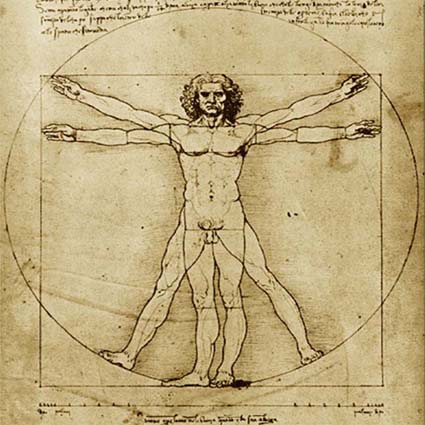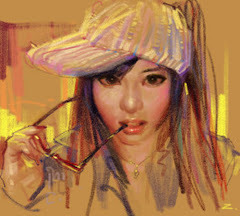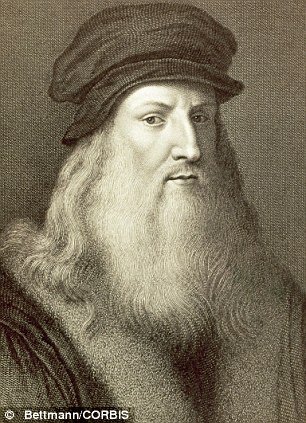
Leonardo da Vinci Paintings
Shortly after his return to Florence, he and Michelangelo were commissioned to paint frescos on the walls of the new city hall. While he was working on his mural depicting the battle of Anghiari, which had been commissioned in part by Niccolo Machiavelli, Leonardo also painted his most famous work, the Mona Lisa. Leonardo was born in Vinci, Italy on April 15th, 1452, the illegitimate son of a young notary. Leonardo grew up in an environment rich with scholarly texts and art, provided by his father, who himself taught Leonardo how to paint, and by his father's family.

Leonardo da Vinci Paintings
Leonardo's first moment in the sun came when Verroccio asked him to help paint an angel in his "Baptism of Christ" piece. Leonardo so impressed his master that Verrochio himself decided he would never paint again. Leonardo continued working with Verrochio for a few years, and then the two parted ways. Leonardo went on to be in the service of the Duke Ludovico Sforza of Milan, where he remained for 16 years. Leonardo didn't only paint for the Duke, but he also designed machinery, weapons, and a fair bit of architecture. Science and art were merged in an unending output of impressive works and studies.

Leonardo da Vinci Paintings
Duke Sforza died shortly after the completion of one of Leonardo's most famous work, The Last Supper; Leonardo who had now lost his patron, and decided to leave Milan. He eventually returned to Florence after having traveled, lived, and worked for various patrons throughout Italy.

Leonardo da Vinci Paintings
A short while later, Leonardo's father passed away, leaving his family to fight over the distribution of his assets, of which none went to Leonardo. It was only later and following the death of his uncle that Leonardo would inherit land and money.

Leonardo da Vinci Paintings
Leonardo later went to Rome, and was given living quarters in the Vatican by Pope Leo X, so that he could further explore the arts while working on commissioned pieces for the Church. Leonardo did not create many new paintings during this period, concentrating on his drawings instead; it was quite difficult for Leonardo to pursue his studies of scientific subjects and anatomy while in the employ of the Pope, as the Church frowned upon the dissection of human cadavers.

Leonardo da Vinci Paintings
For the incoronation of King Francis kings Leonardo had designed a mechanical lion automaton that actually walked. Soon thereafter, Leonardo would become "first painter and engineer, and architect of the king." for his final employer, Francis the 1st. in France. He was given his own private residence and studio, in which he taught, and continued work on his studies, drawings, and sketches. At this point, Leonardo was quite aged, and even though he was left-handed, paralysis of his right hand made it very difficult for him to work.
Leonardo da Vinci Paintings
Painter, sculptor, draughtsman, architect, engineer, anatomist, physicist, astronomer, observer of life in all its forms, and most of all, great thinker. Leonardo is one of our history's most admired geniuses, centuries ahead of his time, one of the first artists to seamlessly merge science and art. Although he only completed 6 major paintings in his entire career, they include some of the most important images ever known.

Leonardo da Vinci Paintings
In 1466, at the age of fourteen, Leonardo was apprenticed to the artist Andrea di Cione, known as Verrocchio, whose workshop was "one of the finest in Florence". Other famous painters apprenticed or associated with the workshop include Domenico Ghirlandaio, Perugino, Botticelli, and Lorenzo di Credi. Leonardo would have been exposed to both theoretical training and a vast range of technical skills including drafting, chemistry, metallurgy, metal working, plaster casting, leather working, mechanics and carpentry as well as the artistic skills of drawing, painting, sculpting and modelling.

Leonardo da Vinci Paintings
Leonardo's early life has been the subject of historical conjecture. Vasari, the 16th-century biographer of Renaissance painters tells of how a local peasant made himself a round shield and requested that Ser Piero have it painted for him. Leonardo responded with a painting of a monster spitting fire which was so terrifying that Ser Piero sold it to a Florentine art dealer, who sold it to the Duke of Milan. Meanwhile, having made a profit, Ser Piero bought a shield decorated with a heart pierced by an arrow, which he gave to the peasant.

Leonardo da Vinci Paintings
Florence, at the time of Leonardo's youth, was the centre of Christian Humanist thought and culture. Leonardo commenced his apprenticeship with Verrocchio in 1466, the year that Verrocchio's master, the great sculptor Donatello, died. The painter Uccello whose early experiments with perspective were to influence the development of landscape painting, was a very old man. The painters Piero della Francesca and Fra Filippo Lippi, sculptor Luca della Robbia, and architect and writer Leon Battista Alberti were in their sixties. The successful artists of the next generation were Leonardo's teacher Verrocchio.

Leonardo da Vinci Paintings
Leonardo's youth was spent in a Florence that was ornamented by the works of these artists and by Donatello's contemporaries, Masaccio whose figurative frescoes were imbued with realism and emotion and Ghiberti whose Gates of Paradise, gleaming with gold leaf, displayed the art of combining complex figure compositions with detailed architectural backgrounds. Piero della Francesca had made a detailed study of perspective, and was the first painter to make a scientific study of light. These studies and Alberti's Treatise were to have a profound effect on younger artists and in particular on Leonardo's own observations and artworks.
Leonardo da Vinci Paintings
Leonardo was a contemporary of Botticelli, Domenico Ghirlandaio and Perugino, who were all slightly older than he was. He would have met them at the workshop of Verrocchio, with whom they had associations, and at the Academy of the Medici. Botticelli was a particular favourite of the Medici family and thus his success as a painter was assured. Ghirlandaio and Perugino were both prolific and ran large workshops. They competently delivered commissions to well-satisfied patrons who appreciated Ghirlandaio's ability to portray the wealthy citizens of Florence within large religious frescoes, and Perugino's ability to deliver a multitude of saints and angels of unfailing sweetness and innocence.
Leonardo da Vinci Paintings
In 1476, during the time of Leonardo's association with Verrocchio's workshop, the Portinari Altarpiece by Hugo van der Goes arrived in Florence, bringing new painterly techniques from Northern Europe which were to profoundly effect Leonardo, Ghirlandaio, Perugino and others. In 1479, the Sicilian painter Antonello da Messina, who worked exclusively in oils, traveled north on his way to Venice, where the leading painter, Giovanni Bellini adopted the technique of oil painting, quickly making it the preferred method in Venice. Leonardo was also later to visit Venice.
Leonardo da Vinci Paintings
This is one of the most beautiful Leonardo da Vinci paintings that used the “sfumato” technique. The sfumato technique was used to tone down a picture and make the picture look like it is evaporating into thin air. In fact, the Italian word “sfumato” actually means to evaporate like smoke. The picture depicts the Madonna in the center. Also in the picture is John the Baptist and Jesus. An angel named Gabriel is also present. The picture depicts Jesus blessing John while John holds his hands outstretched at Jesus. Two versions of this painting were created. The one described above is the Louvre version that was completed between the years 1483 and 1486. The other version is popularly known as the London version which was completed in 1495-1508.

Leonardo da Vinci Paintings
If there are two versions of Leonardo da Vinci paintings, they are usually referred to as the Louvre version or the London version as they are usually displayed at either the museum in Louvre, Paris or the National Gallery in London.

Leonardo da Vinci Paintings
This is one of the rarest Leonardo da Vinci paintings as he had used a male subject instead of a female one that is so characteristic of all his other paintings. The picture depicts a musician holding a scroll of paper, thought to contain notes of music. There has been some controversy about this Leonardo da Vinci painting as some claim it to be a self portrait while some claim it to be a painting that was started by Leonardo da Vinci but completed by some other painter.
Leonardo da Vinci Paintings
Certainly these are just four works of Leonardo da Vinci selected to introduce you to the magnificence of the works of a genius. Other work that should be covered if not for the fear of creating an epic prologue to the master of high renaissance is the Adoration of Mag, and in fact, so much more including his famous drawings and engineered designs.

Leonardo da Vinci Paintings
It is not just Leonardo da Vinci’s paintings that have made him famous to almost everyone in the world. He was a man of exceptional talent who also conceptualized the helicopter, a tank, solar power and even a calculator in times when civilization was just at the grassroots level. He was truly a remarkable genius who touched down on this earth during his times. As with any exceptionally talented people, he also had his share of eccentricities, with his downfall being that he was a chronic procrastinator. It is because of this reason that there are only about 15 known preserved Leonardo da Vinci paintings available today.

Leonardo da Vinci Paintings
Reproductions of Leonardo da Vinci's paintings are best served as framed art prints which finish the original brilliance of the artist with a professional touch that looks great in most homes. Younger fans may instead go for posters or stretched canvases instead. The art market is now flooded with Da Vinci reproductions, with many offering alternative versions of the original paintings, such as cropped elements in greater detail or slightly different tonal and colour balances.

Leonardo da Vinci Paintings
Leonardo da Vinci was certainly the most influential of artists, with a great breadth of talent that is unsurpassed by any human, and only matched by Michelangelo. The Renaissance was led by these two figureheads, with others adding their own more narrow specialties on top to drive European art development onwards. Italian art peaked during this period and has never risen to the same levels since, in terms of influence on other countries and as such Leonardo da Vinci will always be amongst the most respected painters and sketchers with in the country.
Post Title
→Leonardo da Vinci Paintings
Post URL
→https://popularpainters.blogspot.com/2011/10/leonardo-da-vinci-paintings.html
Visit Famous Painter for Daily Updated Wedding Dresses Collection

